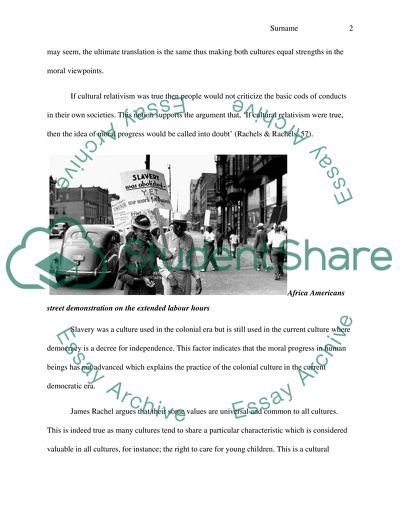In the kaleidoscopic domain of cultural expression, the intersection of artistry and ideology shines prominently, perhaps most vividly illustrated through the phenomenon of cultural relativism. This concept, an intellectual construct that advocates for the appreciation of cultural practices within their own context, invites us into a realm where diversity is celebrated rather than homogenized. When we consider the medium of poster-making, we can discern a powerful vehicle for conveying this idea—particularly through examining the winner of a cultural relativism poster-making competition. The poster emerges not merely as a canvas of color and design but as a metaphor, a bridge linking disparate worlds, illustrating the beauty of difference while urging viewers to suspend their ethnocentric judgments.
To embark upon this exploration, we must first understand the underlying premise of cultural relativism itself. At its core, cultural relativism posits that norms and values are culture-specific and that one must engage with these values on their own terms. It underscores the futility of imposing one’s cultural worldview onto another. In an era where globalization threatens to dilute distinct cultural narratives, this perspective becomes an essential point of reference. The winning poster encapsulates this very essence, encapsulating a mosaic of traditions, beliefs, and practices that beckon acknowledgment rather than critique.
The unique appeal of the cultural relativism poster lies in its visual symphony—an orchestration of symbols, colors, and textures that come together to form a narrative more profound than words alone could convey. The captivating imagery might feature a myriad of cultural icons: the intricate patterns of indigenous textiles, the delicate brush strokes of traditional art forms, and the vibrant hues representative of various celebrations and rituals across the globe. Every element is a brushstroke on the canvas of humanity, suggesting that each culture is an indispensable part of the larger picture, much like puzzle pieces fitting together to reveal a comprehensive landscape.
Conflict often arises when differing cultural paradigms collide, reminiscent of the clash of titans in mythology. But instead of fostering animosity, this poster serves as a clarion call for empathy and understanding, urging its audience to navigate the murky waters of cultural diversity with sensitivity and openness. It generates a juxtaposition—one that invites contemplative intrigue. Consider how a colorful depiction of a festival in one culture may overlap with the solemnity of another’s ritual; each aspect deserves acknowledgment, not derision.
Moreover, the winning poster likely employs strategic visual metaphors that resonate on both personal and collective levels. A winding river threading through different landscapes could symbolize the journey of cultural exchange, emphasizing that while the course may twist and turn, the essence remains fluid and interconnected. Viewers are invited to immerse themselves in this metaphorical river, allowing their preconceived notions to dissolve and their understanding to flow with newfound clarity.
As viewers stand before the poster, they are not merely passive observers but engaged participants in dialogue, pondering the stories interwoven within the intricate patterns on display. The viewer is compelled to question: How does this artwork mirror my own cultural experience? What lessons can be derived from embracing differences? The importance of this introspective process cannot be overstated; as cultural relativism teaches us, our understanding is deepened not through dismissal but through exploration.
Color, too, plays an essential role in this visual discourse. The poster might be adorned with vibrant shades that capture the vibrancy of human expression, evoking emotions and reactions that transcend language barriers. Colors such as the passionate red of a symbolic flag, the calming blue reminiscent of tranquil waters, or the lush green indicative of life and growth weave together a tapestry of cultural narratives. Each hue evokes visceral responses—sparking curiosity and perhaps even prompting a yearning to know more about the culture it represents.
Furthermore, typography serves as a vital tool in communicating the ideals underlying cultural relativism. Whether through the use of bold, modern fonts juxtaposed with elegant, traditional scripts, the poster could reflect the dichotomy of progressive thought and historic roots. This melding signifies that while cultures evolve, they also retain essence and integrity, belonging to a continuum that honors both tradition and modernity. It underscores the notion that cultural evolution is not a linear process but rather a rich tapestry of influences and adaptations.
It is essential to recognize the poster not just as an artistic endeavor but as an educational instrument. It has the potential to incite discourse, ignite passion, and inspire change. People who encounter it are provoked to consider their role in a multicultural society. The act of displaying such a piece in public forums—schools, community centers, or cultural events—propagates awareness and understanding, rendering cultural relativism more accessible to the masses. The poster becomes a catalyst for conversations that might reshape perceptions and foster inclusivity.
In conclusion, the cultural relativism poster-making competition winner represents far more than a mere accolade for artistic merit. It serves as an emblem of our shared humanity—a reminder that beneath the surface of our diverse cultural practices lies a common thread that binds us all. Through captivating visuals, profound symbolism, and an invitation for introspection, the poster transcends the confines of traditional artistic expression, beckoning viewers to engage in the beautiful complexity of cultural diversity. Thus, as we celebrate creativity and cultural nuance, may we always be guided by the principles of empathy, understanding, and respect.
